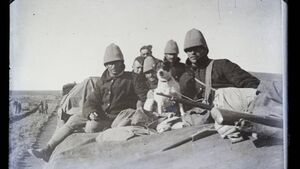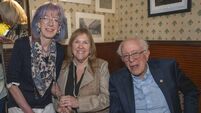Lost art of letters illuminate Athy's past

Vintage photograph from the time of The Second Boer War (1899 aa 1902) in South Africa showing a group of British Soldiers sat on top of a troop train carriage with their kit and pet dog
WHILE browsing in a bookshop recently I came across a recent publication titled .
It is a compilation, by Sean Usher, as he describes it of the ‘World’s Most Entertaining, Inspiring and Unusual Letters’.
Included was a letter by Patrick Hitler to US President Franklin Roosevelt on 3 March 1942 seeking permission to enlist in the US Navy.
Patrick of course was the nephew of Adolf Hitler and his mother Bridget was from the Athy area.
This interesting collection made me reflect on the importance of the letters as repositories of our collective histories.
Often these letters are written by townspeople who are far from our shores and sometimes at war.
One such letter was published in the Leinster Leader on the 23 June 1900 from an unnamed correspondent from Athy who was fighting in the Boer War in South Africa.
Described in the paper as “an Athy Yeoman” he was serving in the 74th Dublin Company of the Imperial Yeomanry, a mounted volunteer unit. Writing from Stellenbosch Camp on the 28 May 1900 he described the town of Colesberg.
The town comprised of about 6,000 inhabitants (which was a little bit bigger than Athy at the time) and of which “half of the people in it are rebels and the other half are loyalists”.
Perhaps with the view to ingratiating themselves with the locals the troops hosted an ’entertainment’ one night.
The Athy cavalryman was first up singing and then gave an encore with the song .
In concluding the letter, he wrote: ‘The officers brought our company on a mountain climbing expedition last week. We rode about 14 miles, and then left our horses at the base, where we proceeded on foot with our rifles.
‘The mountains are full of buck, a sort of deer. We brought back four, from which we dined very well. I am rather pressed for time, so I must conclude with the hope that all home are well.
‘Tell all the boys in Athy that I was enquiring for them, and also the girls. Your affectionate brother.’
Postal services and their provision have been a source of controversy in the past and I was intrigued to come across a debate in the Dail on 15 April 1975 between Dr Conor Cruise O’Brien, the then Minister for Post and Telegraphs, and Paddy Power TD over the provision of a post box in Ballyroe, Athy.
Deputy Power was bemoaning the lack of a post box in Ballyroe and was asking was “the Minister aware that the residents of the Ballyroe area have to travel three and a half miles to post a letter and does he not think that they deserve better facilities than that?”.
The Minister replied: “The facilities provided are equivalent to those provided generally and those which in the past have been provided for small rural districts and thinly populated areas like this.”
The exchange continued but Power was unsuccessful in his submissions to the minister.
The minister answered simply ‘no’ when posed his final question, “would the Minister not consider to have one postal official travel three miles a day rather than have a certain number of people from Ballyroe travelling three miles to Athy”.
The cholera outbreak of 1832 might have escaped my notice had I not come across correspondence (held in the National Archives) regarding meetings held in the Athy Courthouse (at that time in the Town Hall) where the inhabitants had gathered to nominate a Board of Health to deal with the threat of cholera which had broken out in the town.
The letter from the townspeople who had gathered also requested that the central Board of Health in Dublin would provide them with a medical practitioner.
This request was supported by a letter from Thomas Fitzgerald, the High Sheriff of County Kildare who resided in Geraldine, Athy.
It appeared from the correspondence that the outbreak was attributable to a man who died in the town having travelled over from Portarlington.
I often think of the Irish scholar and antiquarian — John O’Donovan who visited Athy in November 1837 and remained in the town for a period of 10 days.
His research into local place names and the collection of local historic material was detailed in a series of letters he sent back to the historical department of the ordinance survey of Ireland.
Writing from Athy on the 22 November 1837 he described the weather as being “very unfavourable to our researchers”.
But nonetheless he detailed the antiquarian remains in Athy which he found consisting of the old Parish Church of St Michael’s and St John’s, the Castle of Woodstock and the South East Gate (known as Preston’s Gate).
The latter structure would be demolished by the Town Council of 1860 after an accident involving the Church of Ireland rector, Reverend Frederick Trench from Kilmoroney.
There is no doubt that the modern reliance on emails and texts is to the detriment of historians, given the disposal nature of these communications.
What letters, if any, from the 21st Century will survive for the historians of the future to peruse?






